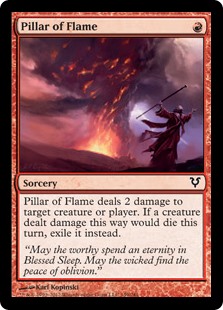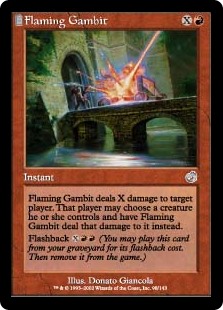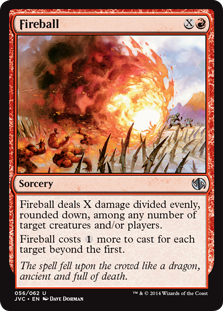Card Evaluation
Introduction
When faced with building a deck from a small subset of random cards it's important to be able to determine, rather quickly, which cards are "playable", which cards are "finishers", and which cards should be avoided. Though cards also need to be evaluated in the context of the expected metagame, there are some basic concepts to keep in mind when selecting cards for a deck.
The first objective is to decide which colors to play, and which cards in those colors are most playable.
A rule-of-thumb in sealed deck construction is to run two main colors and splash a third.
It's unlikely that there will be enough good cards in one color to make a complete deck, plus, mono-colored decks lose out on the resources available through the other colors.
See this page for a brief discussion on color flavor and focus.
There are currently 8 card types in Magic:
Artifact
Creature
Enchantment
Instant
Land
Planeswalker
Sorcery
Tribal
Planeswalker and Tribal are recent expansions on the original game.
The guideline for a 40 card deck is 16-17 creatures, 6-7 other cards, and 17 land cards.
The sections below discuss card evaluation by type, beginning with creatures, as sealed deck games are typically won through creature-based damage.
Creature Cards
Creature cards are usually the most important consideration in sealed deck building. It's unlikely a random booster pool will have the cards needed to build a combo deck (see deck types). More likely the deck will be either aggro or control.
Aggro decks want to get creatures out fast to attack and win early. Control decks want early defense and disruption (eg: Counterspell, Doom Blade) to stall the game and build the mana base to play a finisher - usually a large creature with evasion.
Aggro
Are there enough low cost creatures to be able to use the full mana base each turn?Are there any creatures with haste?
Are the creatures efficiently costed?
Control
Does the card pool have a good finisher (eg: Blightsteel Colossus)?Are there enough disruption cards available?
Are there versatile creature cards (eg: Aethersnipe)?
Efficiency
Efficiency in creature cards takes into consideration:power and toughness
mana cost
abilities
Creatures without abilities are often referred to as vanilla.
The original Alpha Edition vanilla creatures were, Grizzly Bears, Gray Ogre, and Hill Giant.
In deckbuilding, a 2/2 creature with no abilities that costs one colored mana and one colorless mana to play is referred to as a bear, a vanilla 2/2 for 3 an ogre, and a vanilla 3/3 for 4 a giant. Among these three cards, the Grizzly Bears is the more efficient creature. It's certainly better than the 2/2 for 3 Ogre, and for the same cost two Bears are better than one Giant.
Green, by design, has the more efficient creatures, which is why, of the original vanilla creatures, Grizzly Bears was more more efficient.
Today the bear, ogre and giant serve as a gauge to evaluate creatures for deckbuilding.
A vanilla 2/2 creature for 2 mana is ok in a sealed deck build, but would likely not make it into a standard constructed deck.
When evaluating creatures for deck building, good creatures have useful abilities with a vanilla power/toughness to mana cost ratio, or better.
Persistance
A Doom Blade'd Iona Shield of Emeria isn't a finisher in the graveyard.Creatures need to stick around to help win the game.
Abilities like regenerate or hexproof make a creature very difficult to kill. So can abilities that increase a creature's power/toughness like Ghostly Changeling.
Evasion
Evasion is any creature ability that can prevent defenders from blocking it in combat like flying, intimidate, or landwalk.In a match where the battlefield is crowded with creatures, it can be difficult to get past an opponent's defenses. This is where creatures with evasion are important.
Instant and Sorcery Cards
Instants and Sorcery cards are similar in that their spells have a one-time effect, and the card does not become a permanent on the battlefield.
There are a wide variety of effects created by sorcery and instant cards.
They can deal damage, cause life loss, cause life gain, prevent life loss, make creatures bigger, badder, faster.
Instant and sorcery effects can kill creatures, or resurect them.
They can make mana, draw cards, discard cards, return cards from play to hand, remove cards from the game or stop your opponents spells.
An Instant may be cast just about any time, and on any player's turn.
A Sorcery can only be be cast on the card holder's turn, and not while other spells are on the "stack" (see strategy section).
Sorcery spells are "slower" but generally have a better effect than a similar cost instant.
Compare direct damage cards costing just  .
.


or the uber versions costing



or the uber versions costing
In both cases the sorcery cards have a better effect, but are restricted to when they can be used.
Sorcery and instant cards are offensive and defensive tools that help players solve problems and tip the balance of power in their direction.
An offensive Instant or Sorcery should result in the opponent losing life points.
A defensive Instant or Sorcery will do things that disrupt the opponent's offense or stalls their progress, essentially their effects include removing/neutralizing a permanent on the battlefield or countering a cast spell.
When building a sealed aggro deck, include one or two offensive spells as finishers in case the battlefield gets mired.
Defensive spells should make up the balance of non-creature spells in control decks.
Enchantment Cards
There are two type of enchantment cards, those that enter the battlefield and affect the overall game state for a player or players, and those that enchant a permanent in play. Examples of the former incude Ajanis Mantra and Arcane Melee. Examples of the latter (called Auras) are Pacifism and Fear.
Playing auras on your creatures is risky. If the enchanted creature is killed, the aura goes to the graveyard too. This results in card advantage (see strategy page) for your opponent.
You lose two cards, your opponent maybe loses one.
Some auras address the card advantage issue by including a replacement effect like card drawing, Travelers Cloak or persistance like Rancor
Auras that are played on creatures your opponent controls are considered removal spells. Playing Pacifisism on your opponent's big creature "removes" it as a threat, stalls your opponent and forces them to use resources to deal with it.
Sealed Deck matches are often won by the player with card advantage, so when deckbuilding, it's best to leave those "enchanted creature gets +1/+1" cards in the sideboard and it's ok to put one or two of those "enchanted creature doesn't untap during its controller's untap step" cards into your deck.
Artifact Cards
Artifact cards are primarily colorless physical items imbued with magical power.
Some Artifacts have a subtype creature or equipment. Artifact Creatures are animated mechanical devices, Artifact Equipment are wearable items grant abilities to creatures.
Artifact creatures can be evaluated like other creatures are, based on cost, power/toughness and abilities.
Equipment are more persistance than Auras. When a creature dies, its attached equipment remains on the battlefield and can be re-attached to another creature, whereas Auras go to the graveyard.
A Wispersilk Cloak equipped finisher would make for a short game.
Artifacts like Azorius Signet can be used to fix and accelerate the mana base. The signet accelerates the mana base because it makes an additional mana source beyond the normal one-land-per-turn pace of the game. It fixes mana by providing two different colors. This signet can produce the mana to pay for
When choosing Artifact cards for a sealed deck build, be sure the card works with other cards and advances the deck's overall plan.
Planeswalker and Tribal Cards
A Planeswalker in play is not considered a creature.
A Planeswalker is more like another team member that adds abilities to your side. Planeswalkers have loyalty points instead of power and toughness. A planeswalker with zero loyalty dies.
Players can have their combat damage that would normally be assigned to an opponent redirected to the opponent's Planeswalker instead. Damage assigned to a planeswalker reduces its loyalty points, one-for-one.
A planeswalker that isn't too expensive can be a damage sink if its abilities are threatening enough like Jace the Mind Sculptor.
Planeswalkers are mythic rares.
Few people get one in their card pool.
Tribal cards are not really a unique type of card, they are more of a sub-type.
Each card that is Tribal is also another cardtype.
A tribal card is played according to the associated type: tribal instants are played like instants, tribal enchantments like enchantments. Cards like Tarmogoyf that count card types, include Tribal cards. In fact, Tribal cards and Tarmogoyf were introduced in the same set, Future Sight.
Unless the card pool contains enough tribal cards and other cards that care about them, it's best to evaualte the Tribal cards as their primary card type.




